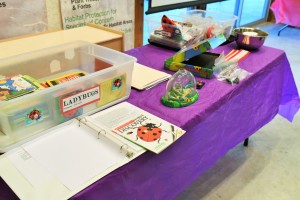Discoveries in Nature Boxes

Originally appears in the Spring 2016 issue
“There’s the Nature Box Ladies!” is a commonly heard phrase shouted out by eager children in our area when they see a well-known group of educators arrive at their school. Students often remember the presenters of Nature Boxes years after they visit and will stop them at the local grocery store, or other areas about town, to remind them what a great time they had. Recently a kindergarten teacher noted that, “The children are always engaged and discuss the information they have learned. It is a great way for them to make a connection.” Inspired by their first encounter with the program in 2007, a group of Cibolo Creek Elementary students raised funds to purchase the materials for what would become the Cibolo Prairie box. This is now one of many Nature Boxes making their way around area schools. As a free program offered to local preschool through 5th Grade students, the program depends heavily on donations such as these.
Located in Boerne, Texas, the Cibolo Nature Center & Farm is home to four unique ecosystems: a tallgrass prairie, riparian forest, live oak savannah, and spring-fed marsh. The Nature Box program takes our “place” to area classrooms through hands-on, inquiry-based learning that focuses on these four ecosystems. It was developed by two retired teachers in order to reach school children who were unable to visit the nature center, and operates much like a field trip in a box. An army of volunteers provide science and nature-based education into the classroom for study and exploration by bringing all the materials and facilitating the lessons. The materials found in each box enable multiple activities that relate to theme; such as bats, native plants, watersheds, and local geology. Some of the boxes cover general science topics such as the phases of the moon, with a unique place-based approach that helps make an abstract topic familiar. Aligned with state education standards, all of the activities are designed to enhance current school curriculum. Now reaching approximately 7,000 students annually, there are currently 36 different boxes in operation, spanning Pre-Kindergarten through 5th grade.
The Nature Box program is an easily replicable program that classroom teachers, parents, and informal educators can use to enhance their curriculum and inspire young minds to gain a deeper sense of wonder and connection to the environment. In today’s early childhood setting, less and less time is dedicated to the sciences. Nature Boxes allow the educator to weave science into other studies, such as reading and math. This is achievable by integrating literature and mathematical concepts throughout the lessons, regardless of theme. Nature Boxes are place-based, meaning the students are learning about their local ecosystems, which makes learning more meaningful and relevant to them. Nature Boxes allow for in-classroom discovery of place, while encouraging at-home explorations of the child’s larger community.
To view the photo-rich magazine version, click here.
If you are not already a subscriber, please subscribe to read the full article
To buy this article for $0.99, please click on: ![]()
Megan Woolard Arredondo is a middle school science teacher who grew up around the Cibolo Nature Center & Farm and often volunteers her time with their programming. She has a Masters degree in Environmental Education and has developed curriculum in a variety of non-profit and formal educational settings. The CNC&F Nature Box Program was developed by volunteers, and retired educators, Dr. Kathy Ward and Kathy Wilson.
Resources
Curriculum Guides
Harrison, Patricia. Texas Prairies: An Integrated Curriculum for Grades 4&5. Fort Worth, TX: The Botanical Research Institute of Texas, 1996. Print.
The “Texas Prairies” curriculum from the Botanical Reacher Institute of Texas (BRIT) has a great deal of general information that is relevant to all prairie ecosystems and is a good resource regardless of where you live. If you are unable to obtain a copy of the curriculum, a general internet search for “parts of a grass plant” will provide you with useful diagrams. As a side note, BRIT is a global botanical research institute offering a variety of resources that might prove useful to any region.
Visuals
Hundley, Eunice. Life in the Cibolo Tallgrass Prairie. 1999. Print. Available at: http://www.eunicehundley.com/Murals/Pages/Cibolo_Nature_Center_Mural_-_Boerne,_Texas.html#0
Books & Articles on the Prairies
A Day on the Prairie. New York: Scholastic, 2008. Print. Kids Are Authors.
Dvorak, David. A Sea of Grass: The Tallgrass Prairie. New York, NY: Macmillan, 1994. Print.
Hunter, Anne. What’s in the Meadow? Boston, MA: Houghton Mifflin, 2000. Print.
Rector, Barron. Know Your Grasses. College Station, TX: Texas Cooperative Extension, Texas A&M University, 2003. Print.
Wallace, Marianne D. America’s Prairies and Grasslands: Guide to Plants and Animals. Golden, CO: Fulcrum Resources, 2001. Print.
Books & Articles on Indigenous peoples and Bison
Baker, Olaf. Where the Buffaloes Begin. New York, NY: Puffin Books, 1985. Print. Picture Puffins.
Freedman, Russell. Buffalo Hunt. New York, New York: Holiday House, 1988. Print.
Patent, Dorothy Hinshaw. The Buffalo and the Indians: A Shared Destiny. New York: Clarion Books, 2006. Print.
Simmons, Marc. José’s Buffalo Hunt: A Story from History. Albuquerque, NM: University of New Mexico Press, 2003. Print.
Winner, Cherie. Bison. Minnetonka, MN: NorthWord Press, 2001. Print. Our Wild World Series.
Miscellaneous
Teachers can purchase books, lesson plans, and models for student use from places like Acorn Naturalists (www.acornnaturalists.com) or Nature-Watch (www.nature-watch.com).
End Notes
[1] Dvorak, David. A Sea of Grass: The Tallgrass Prairie. New York, NY: Macmillan, 1994. Print.
[2] A Day on the Prairie. New York: Scholastic, 2008. Print. Kids Are Authors.
[3] Hundley, Eunice. Life in the Cibolo Tallgrass Prairie. 1999. Print.
Leave a Reply
You must be logged in to post a comment.





